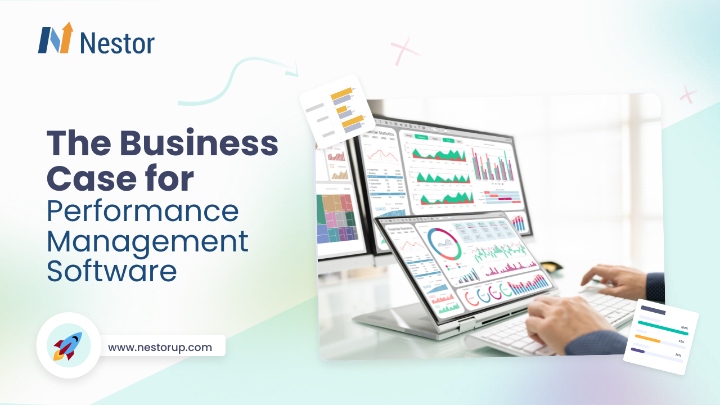Talent Management ROI Calculator: How to Justify Your Investment to Leadership
25 min read

Contents
When you ask for talent management software, your CFO will ask two things: How fast do we earn our money back? and How confident are you in the assumptions?
If you can’t answer that in plain numbers, the request stalls.
The pain is real and expensive. Attrition drains teams and cash. Agency invoices pile up. Roles sit open while managers juggle overtime, morale dips, and projects slip. Every empty chair has a daily cost. Every rehire burns time and fees. None of this is “soft.”
Leadership isn’t against talent. They’re against uncertain returns. They fund sales tech because revenue looks direct; HR tech often looks like a cost. To change that frame, you need something simple and defensible: ROI that maps people outcomes to money.
That means translating familiar signals into cash effects. Fewer exits turn into avoided replacement spend. Faster hiring cuts vacancy days. Cleaner recruiting trims cost-per-hire. Smarter learning reduces wasted licenses. A small, credible lift in performance adds up across the team. Then you subtract software, setup, and admin. What’s left is the case.
This is the language that buys leadership:
- Payback (months). How fast the spend comes back.
- Annual net benefit. Savings minus all costs.
- Three-year NPV. Value after you apply your discount rate.
The tone here is plain math with plain language. We’ll use conservative assumptions, show ranges instead of hype, and keep the model transparent. By the end, you’ll have three numbers leadership cares about and a short story to match. You own the people plan. This gives you the receipts.
What counts as ROI in talent management (and what doesn’t)
ROI gets thrown around a lot in HR conversations, but finance sees it differently. For them, it’s not about “engagement scores”. ROI is about money saved or earned compared against money spent. In simple terms:
ROI = (Total Benefits – Total Costs) ÷ Total Costs
For talent management software, benefits are the savings you can actually measure: fewer resignations, lower recruiting spend, faster fills, measurable productivity lift, and less waste in learning budgets. Costs are equally straightforward: subscription fees, implementation, and the people who administer the system.
That’s the formula, but it’s only the first step. Most finance teams won’t sign off based on ROI alone. They’ll ask for:
- Payback period: How many months until the investment pays for itself. This matters more to CFOs than ROI %, because it shows liquidity risk.
- Net present value (NPV): The value of projected net benefits over a set period, usually three years, discounted at your company’s cost of capital (the WACC). It’s the yardstick finance uses to compare projects.
NetSuite describes ROI as the balance between benefits and costs, while Investopedia stresses the importance of using ROI alongside payback and NPV to evaluate investments. Put differently: if ROI is the snapshot, payback and NPV are the moving picture that makes leadership comfortable.
So what doesn’t count? The “soft” stuff that HR leaders often love to highlight:
- Morale, unless it’s tied to measurable retention gains.
- Generic culture claims, without any baseline cost impact.
- Engagement scores that don’t link to turnover or productivity.
This isn’t about dismissing those elements. They matter. But they won’t win budget approval. Executives want to see HR framed in their language: cash in, cash out, and risk managed.
The ROI drivers you can defend
So what should you include? The levers where you can show a clear, causal path from people outcomes to financial impact. Use your company’s own numbers whenever possible; external benchmarks are just a sanity check, not a substitute for your data.
Here are the five drivers that stand up in a finance meeting:
Reduced Turnover
Replacing people is expensive, and not just because of recruiter fees. The costs pile up: job ads, interviews, onboarding, ramp-up time, and the productivity that walks out the door when someone leaves.
Data to gather:
- Headcount
- Current turnover rate
- Target reduction (realistic, not heroic)
- Average fully loaded cost per employee
- Mix of roles (entry-level vs leadership)
Benchmarks: Gallup puts replacement cost anywhere from 0.5 to 2× salary, depending on the role. The Center for American Progress estimates around 20% of salary for many positions, with executives often far higher.
How to present: show the math in plain terms: “Reducing turnover by 2 percentage points saves $X, based on our replacement costs.” If you can, split the estimate by role level; it makes the claim harder to challenge.
Lower Cost-per-Hire
Recruiting has its own price tag. Every hire carries the weight of ads, agency fees, recruiter time, interview hours, and technology subscriptions.
Data to gather:
- Number of hires per year
- Total internal recruiting spend (staff time, tech, overhead)
- External spend (agencies, job boards)
Definition reference: Both AIHR and Paylocity define CPH as the sum of all recruiting costs divided by total hires. Align on this definition with Finance so there’s no debate.
How to present: highlight where savings come from: fewer agency placements, more efficient use of recruiter time, or consolidation of tools. A simple line works: “Average cost-per-hire reduced by 12% saves $X per year.”
Faster Time-to-Fill (vacancy cost)
Every extra day a role stays empty is a day of lost output. That gap is often covered by overtime, project delays, or in some cases, lost revenue.
Data to gather:
- Average time-to-fill before and after software
- Number of hires per year
- Estimated cost of vacancy per day (you can use fully loaded cost ÷ 260 working days as a conservative proxy, or contribution margin per role if finance prefers)
Definition reference: Paylocity defines time-to-fill as the number of days between job posting and acceptance. HR Lineup explains vacancy cost as the financial impact of leaving roles unfilled.
How to present: tie fewer vacancy days to actual cash impact. For example: “Cutting time-to-fill by 7 days across 150 hires saves $X annually.” That lands better than vague talk of efficiency.
Modest Productivity Uplift (keep it conservative)
Software doesn’t magically double performance. But structured goal setting, manager check-ins, and skills tracking do nudge output. Even a half-percent gain across hundreds of employees is meaningful.
Data to gather:
- Surviving employees (after projected turnover)
- Average fully loaded cost
- Productivity lift percentage (be cautious—0.5% to 1% is credible)
- Contribution-to-value factor (typically 0.2–0.3, reflecting the portion of productivity that translates to profit)
How to present: be upfront that this is the least tangible lever, so you’ve kept the estimate modest. Finance will respect the restraint. Position it as upside, not the core of your case.
Optimized Learning Spend
Most companies overspend on training content; duplicate licenses, underused platforms, or generic courses with no uptake. Talent management software helps trim the fat by mapping training to real skill gaps.
Data to gather:
- L&D budget per employee
- Company-wide training spend
- Reduction percentage (5–15% is realistic if you consolidate and target)
How to present: “Reducing L&D waste by 10% frees $X annually, without cutting learning opportunities.” This is one of the cleanest savings lines in the model because it deals with hard invoices.
Inputs you’ll need (and where to find them)
A strong ROI case doesn’t need hundreds of data points. What it does need are a handful of numbers that tie directly to money in or money out. If you can show leadership where each figure comes from (your HR system, your recruiting platform, or your finance reports) you’ve already set yourself apart from the average pitch.
Workforce basics
- Headcount: the average number of employees across the year. Don’t use a single snapshot; averaging smooths out seasonal swings.
- Fully loaded cost per employee: salary plus benefits, taxes, and overhead. Finance usually has this; if not, take average salary and add 30–40% as a proxy.
- Turnover rate: percentage of employees leaving each year. Use a full 12 months of data. If you can, split voluntary from involuntary, because voluntary exits are where savings are most visible.
Hiring and recruiting
- Annual hires: total hires (new roles + backfills).
- Cost-per-hire (CPH): all recruiting costs (internal team, tools, advertising, agencies) divided by hires. Stick to this definition so Finance doesn’t dispute your math.
- Time-to-fill (TTF): average days between opening a role and having an accepted offer. Clarify this metric upfront, since different teams sometimes use slightly different definitions.
Productivity and output
- Surviving employees: total headcount minus projected leavers. This is the group that benefits from performance improvements.
- Productivity lift %: a modest bump from clearer goals and structured feedback. Keep it conservative (0.5–1.0%).
- Contribution-to-profit factor: not every dollar of salary translates to profit. A common shortcut is applying your company’s contribution margin (often around 20–30%). Ask Finance for the official figure; they’ll like being consulted.
Learning and development
- Annual L&D spend per employee: include training budgets, external content, and learning platforms.
- Reduction %: the percentage you expect to cut by consolidating providers or removing unused licenses. A 5–15% assumption is usually defensible.
Costs of the system
- Software subscription: usually priced per employee per month.
- Implementation: one-time costs for setup, integrations, and training.
- Administration: the HR operations time it takes to run the platform. Estimate hours, then convert them into a share of an FTE using fully loaded cost.
Finance-specific levers
- Discount rate (WACC): Finance’s way of valuing future money in today’s terms. Ask for the actual number; if unavailable, use 8–12% and label it clearly.
- Escalation assumptions: optional, but Finance may want to see costs or savings adjusted for inflation over a three-year horizon.
Building the talent management business case in 6 steps
Making a financial case for talent management isn’t just an HR exercise. It’s a way of showing leadership how investments in people strategy translate into measurable business outcomes. A clear framework helps transform a proposal into a model that CFOs and CEOs can evaluate alongside other projects competing for budget.
Here’s a step-by-step method to build that case with confidence:
1. Collect your talent management baseline
Start by gathering the current state of your workforce. That means turnover rates, average cost-per-hire, time-to-fill, learning and development spend, and the fully loaded cost per employee. This baseline is the “control group” against which improvements are measured. Accuracy matters here: numbers should come straight from HR systems or finance reports, not estimates.
2. Define realistic improvement goals
The biggest credibility mistake in talent management ROI cases is overpromising. Avoid bold claims like cutting turnover in half. Instead, model conservative gains:
- Turnover reduced by 2–3 percentage points
- Cost-per-hire lowered 10–15%
- Time-to-fill shortened by 5–10 days
- Learning and development spend reduced 5–10%
By keeping assumptions modest, you show leadership that talent management improvements can be steady and believable.
3. Convert outcomes into financial impact
This is where the HR language becomes finance language. Each improvement gets translated into dollars:
- Fewer exits multiplied by replacement cost = turnover savings
- Lower recruiting expenses per hire = cost-per-hire savings
- Shorter vacancies multiplied by cost per day = time-to-fill savings
- Smarter training budgets = direct L&D savings
Linking each talent management metric to cash impact makes the story much stronger.
4. Subtract investment costs
Every business case must show costs clearly. Break them into:
- Software subscription fees
- One-time implementation and integration costs
- Ongoing administrative effort
Separate Year 1 from run-rate costs. Year 1 is always higher because of implementation, but run-rate shows the true long-term cost of managing talent management software.
5. Run the finance metrics: ROI, Payback, and NP
With benefits and costs lined up, calculate the three metrics executives expect:
- ROI % = (Benefits – Costs) ÷ Costs
- Payback period = Costs ÷ (Net Benefit ÷ 12)
- Net Present Value (NPV) = Net benefits over three years, discounted by your company’s cost of capital
These measures allow talent management initiatives to be compared directly against IT projects, marketing investments, or any other capital request.
6. Package the business case for leadershi
Structure your presentation so it’s easy to digest:
- Current cost of talent issues: turnover, recruiting spend, long vacancies, training waste
- Projected benefits: total net savings, payback period in months, and 3-year NPV
- Scenarios: Conservative, Base, and Stretch—lead with the conservative case
- Risks and sensitivities: what happens if turnover only drops one point instead of three, or if adoption takes longer?
By framing talent management ROI this way, you’re not just asking for budget—you’re showing how an HR investment stacks up like any other business project.
Evidence and benchmarks to support your talent management ROI
Leadership teams rarely approve funding without external reference points. While your own data is always the strongest, adding talent management benchmarks shows that your assumptions sit within industry norms. It also links your case to bigger HR themes (succession planning, internal mobility, and skills development) that leadership already hears about in strategy conversations.
Turnover and retention benchmarks
Replacing people is expensive, which is why turnover sits at the center of most talent management ROI models.
- Gallup estimates that the cost of replacing an employee ranges from 0.5× to 2× salary, depending on role complexity.
- The Center for American Progress reported that replacing a worker costs about 20% of annual salary for many positions, but significantly more for leadership.
If your company is also struggling with succession planning, reducing leadership attrition carries even higher value. Losing one senior leader without a successor ready can trigger months of stalled decision-making and costly external searches.
How to use it: Show how a 2–3 percentage point drop in turnover produces savings that align with these ranges, then connect it to improved leadership continuity.
Recruiting efficiency benchmarks
Cost-per-hire (CPH) is widely used and clearly defined: total recruiting costs divided by hires.
- Studies show average CPH in the U.S. often falls between $3,000–$5,000 per hire.
- Agency-heavy recruiting strategies can push that figure much higher.
When you add automation, stronger pipelines, or internal mobility programs that fill roles from within, you reduce both external recruiting spend and the disruption caused by vacancies. Filling a role internally is usually faster and cheaper, and it contributes to retention by showing career growth opportunities.
How to use it: Demonstrate how a modest 10–15% reduction in cost-per-hire is not only defensible but also aligned with research averages.
Time-to-fill and vacancy cost
Open roles drag down performance. According to Paylocity, time-to-fill is the number of days between posting a job and a candidate’s acceptance. When those days add up across dozens or hundreds of hires, the financial cost becomes visible.
A common method is to calculate vacancy cost as fully loaded cost ÷ 260 workdays. For revenue-generating roles, some companies use contribution margin per day instead, which highlights the sales or production impact.
How to use it: Pair your own TTF data with vacancy cost math. Even a 5-day improvement across 100 hires could equal hundreds of thousands of dollars. Tie this back to internal mobility too; filling roles from within usually cuts TTF dramatically.
Productivity lift
Most talent management software promises productivity gains, but CFOs are skeptical if claims feel inflated. The safe approach is modeling a 0.5–1.0% lift applied only to surviving employees. Use a contribution margin factor (say 25%) to keep estimates grounded.
Link this not just to performance reviews but also to skills development and succession planning. Building future leaders internally reduces the risk of leadership gaps, which indirectly protects productivity at scale.
How to use it: Position productivity lift as a secondary benefit, not the core driver, but highlight how it strengthens the case for structured succession planning.
Learning and development spend
The corporate learning market is crowded, and many organizations overspend on overlapping platforms. Research suggests that rationalizing L&D can reduce costs by 5–15% without cutting development opportunities.
If your company is already focused on reskilling or building internal talent pipelines, showing that spend is being redirected, not eliminated, keeps both HR and Finance on board.
How to use it: Present learning savings as efficiency, not reduction. Pair it with a note on how internal mobility and succession planning rely on smarter development, not more licenses.
Why these benchmarks matter
When you line up your ROI model with credible ranges, you answer the CFO’s silent question: “Is this believable?” Tying turnover to succession risk, CPH to internal mobility, and L&D efficiency to career growth makes the case broader than software. It makes it about long-term talent management strategy.
Example scenario: conservative, base, and stretch outcomes
Numbers tell the story best when they’re grounded in a real-world setting. Let’s walk through what a mid-sized organization might see from a talent management investment, using three scenarios: conservative, base, and stretch. The point isn’t to show dramatic upside; it’s to demonstrate how even modest changes add up fast.
Starting point
Picture a company with 500 employees. The average fully loaded cost per person is about $80,000. Annual turnover sits at 20%, which means the business replaces around 100 employees a year. Cost-per-hire averages $4,000, and roles take about 45 days to fill. Learning and development spend is $600 per employee per year, spread across several vendors.
The HR team is also worried about succession planning. Two directors are nearing retirement, and there’s no clear internal pipeline. Recruiting externally for leadership roles costs more and stretches vacancy times further.
This is the baseline. Now let’s model improvements with a new talent management platform.
Conservative case
In the conservative case, HR doesn’t assume miracles. Turnover improves slightly, dropping from 20% to 18%. That saves around $240,000 a year, based on reduced exits and replacement costs. Cost-per-hire falls by 10%, thanks to fewer agency placements and better candidate tracking. Time-to-fill improves by 5 days, which translates into about $140,000 in vacancy savings.
On the development side, the company trims about 5% of its L&D spend by consolidating licenses. Internal mobility fills a handful of roles faster, reducing external recruiting costs. Productivity gains are modeled at just 0.5%, a cautious assumption.
Total benefits: about $470,000 annually. With software, implementation, and admin costs around $150,000 in Year 1, the payback comes in just under four months.
Base case
In the base scenario, adoption is stronger. Turnover falls to 17%, cutting replacement costs by roughly $360,000. Cost-per-hire drops by 15%, and time-to-fill improves by 8 days, which equals another $230,000 in savings.
Because the platform supports clearer career pathways, internal mobility improves significantly. More mid-level roles are filled from within, boosting retention while lowering hiring costs. Learning spend is trimmed by 10%, as the team consolidates underused training platforms. Productivity lift is modeled at 1%.
Here, total benefits reach $870,000. With the same cost structure, Year 1 ROI clears 450%, and the payback period shrinks to about two months.
Stretch case
The stretch case isn’t a sales pitch. It’s what could happen with strong adoption across the business. Turnover drops five points, to 15%. That alone drives over $1 million in savings, given the company’s fully loaded costs. Cost-per-hire falls by 25%, vacancy times improve by nearly two weeks, and internal mobility fills a significant share of leadership and technical roles.
Learning efficiency grows to 15%, and productivity lift is modeled at 2% (still modest compared to what many vendors claim). Crucially, succession planning gaps close as more internal talent is developed, reducing reliance on expensive external searches.
The outcome: nearly $1.9 million in annual benefits. ROI surpasses 1,000%, and payback happens in about a month.
Why this matters
Even in the conservative case, where adoption is limited and assumptions are cautious, the business recoups its investment within the same quarter. The base and stretch scenarios only amplify the story. More importantly, the gains extend beyond cost savings; they build a stronger leadership pipeline, improve internal mobility, and make succession planning less of a scramble.
That’s the kind of ROI leadership cares about: tangible savings today, paired with lower risk and stronger talent resilience tomorrow.
Presenting the business case to leadership
You’ve run the numbers. Now comes the harder part: convincing leadership to say yes. The way you present matters as much as the math. Executives don’t want to sift through a 20-page deck—they want a crisp storyline with the right numbers in the right order.
Here’s how to frame your case.
Slide 1: Executive snapshot
Start strong. Put three numbers front and center:
- Annual net benefit
- Payback (in months)
- 3-year NPV
This is the language Finance trusts. It sets the tone before anyone can drift into questions about “culture” or “engagement.”
Slide 2: The cost of doing nothing
Spell out what the company spends today because of weak talent management. That means:
- Annual turnover cost
- Recruiting spend (internal + external)
- Vacancy cost from long time-to-fill
- Overlapping or underused L&D budgets
Keep it visual: a stacked bar or pie chart works better than a table full of decimals.
Slide 3: What changes with better talent management
This is where you show the levers. Highlight the five drivers you modeled: lower turnover, cheaper recruiting, faster time-to-fill, productivity gains, and smarter L&D spend. If succession planning or internal mobility are priorities, tie them in here—leadership will care about reducing dependency on external hires.
Slide 4: The financial model
Line up your conservative, base, and stretch scenarios side by side. Use simple rows: turnover drop, CPH reduction, vacancy savings, productivity lift, L&D savings, total benefits, costs, ROI, payback.
Finance teams like to see a “range of outcomes.” It shows you’re not relying on one optimistic forecast.
Slide 5: Risks and mitigation
Executives expect challenges. Show you’ve thought about them:
- Adoption risk → plan phased rollout with pilot groups
- Data quality risk → HR + Finance validate assumptions together
- Change fatigue → integrate with current workflows, keep manager effort light
You don’t need to list every possible problem, but show you have a plan for the big ones.
Slide 6: Owners and timeline
Who makes this work? Add names, not just departments. Outline a simple timeline:
- 1–2 Month: setup and integration
- Month 3: pilot groups
- 4–6 Month: wider rollout
- Month 6+: benefits start showing up in turnover and recruiting metrics
Executives like to see when the payback will actually hit the books.
Slide 7: The ask
End with clarity:
- Year-1 cost (software + implementation + admin)
- Run-rate cost (software + admin only)
- Approval path (budget line or capital request)
Close by reminding them: “Even under conservative assumptions, payback is within a single quarter.”
A quick word on tone
Don’t oversell. Stay close to the numbers. Let the story be about financial prudence: reducing waste, filling critical roles faster, and strengthening succession planning. If you show leadership that talent management is a profit-protecting investment, not a “nice to have,” the decision becomes easier.
Implementation & timeline
Even the best talent management software won’t deliver ROI unless the rollout is clear, phased, and tied to ownership. Leadership wants to know: Who is accountable? When do results show up? What’s the risk if timelines slip? The cleaner your plan, the more confidence you’ll build.
Phase 0: Preparation (Weeks 1–2)
- Data audit: confirm accuracy of headcount, turnover, cost-per-hire, and time-to-fill data. This prevents arguments later about “bad inputs.”
- System readiness: IT and HR check integrations with payroll, HRIS, and recruiting platforms.
- Executive alignment: brief Finance and Operations on how ROI will be tracked quarterly.
Phase 1: Setup and integration (Weeks 3–6)
- Configure the software, import employee data, and set up reporting dashboards.
- Connect recruiting, learning, and performance modules so data flows in one place.
- Train HR operations staff on admin tasks and reporting features.
Milestone: Core modules live, early reports visible to HR and Finance.
Phase 2: Pilot program (Weeks 7–12)
- Select 2–3 departments (often where turnover is highest or roles are hardest to fill).
- Run performance cycles, feedback processes, and learning assignments within the platform.
- Track adoption rates and report early outcomes: time-to-fill, mobility moves, feedback completion.
Milestone: Pilot success story captured. Share one case of reduced vacancy or faster internal promotion.
Phase 3: Organization-wide rollout (Months 4–6)
- Expand platform access to all employees and managers.
- Launch internal mobility features, making internal job postings more visible.
- Tie development plans to succession pipelines, especially for critical roles.
Milestone: 80%+ of managers complete a cycle of goal-setting or performance check-ins.
Phase 4: Ongoing monitoring and value tracking (Months 7–12)
- Quarterly review with HR + Finance: turnover changes, hiring efficiency, L&D spend.
- Adjust assumptions in the ROI model with live data.
- Spotlight internal promotions to show succession planning in action.
Milestone: Present first-year ROI with both projected and actual numbers.
Owners and accountability
- HR operations: platform configuration and reporting.
- Recruiting lead: time-to-fill and cost-per-hire metrics.
- L&D lead: learning consolidation and budget efficiency.
- Finance partner: ROI validation and NPV/payback updates.
- Executive sponsor: ensures adoption is tied to business priorities, not just HR.
Why this matters
By breaking implementation into phases, you show leadership that this isn’t just software—it’s a structured talent management strategy. Internal mobility programs, stronger succession planning, and faster hiring improvements don’t appear overnight, but with this timeline, benefits are measurable within a single fiscal year. And by Month 6, adoption patterns are strong enough to make ROI numbers real, not hypothetical.
How Nestor delivers measurable talent management ROI
A calculator gives you the numbers. But to make those numbers real, you need a system that moves the levers we’ve been talking about: retention, hiring costs, productivity, and succession risk. That’s where Nestor comes in.
Unlike tools that only track data in silos, Nestor is built around a skills-based approach to talent management. It ties together performance, development, and mobility in ways that directly impact the financial outcomes leadership cares about.
Here’s how:
- Succession planning made concrete: Identify future leaders early, map them to critical roles, and build development plans. This reduces the risk (and cost) of sudden leadership vacancies.
- Internal mobility as a cost saver: Surface hidden skills and match employees to openings before jobs ever hit the external market. That lowers cost-per-hire, shortens time-to-fill, and improves retention; three of the biggest ROI drivers.
- Performance management that boosts productivity: With structured goal-setting and continuous feedback, managers have a clearer view of output. Even modest productivity gains translate into six-figure benefits when applied at scale.
- Learning spend tied to business needs: Instead of generic training, Nestor links L&D to specific skills required for succession and internal mobility. That means less waste and higher impact per training dollar.
- Evidence you can share with Finance: Nestor tracks turnover, mobility, and performance improvements in real time, giving HR leaders live data to refresh their ROI models.
Final Thoughts on Talent Management ROI
Securing budget for talent management comes down to proving what it delivers in financial terms. When you frame the case around turnover savings, faster hiring, internal mobility, productivity gains, and smarter succession planning, leadership sees more than an HR initiative. They see a business investment with clear payback.
With a structured ROI model and a platform like Nestor to make the results tangible, HR leaders can shift the conversation from “why we need this” to “how soon can we start.”
Frequently Asked Questions about Talent Management ROI
What is a talent management ROI calculator?
A talent management ROI calculator is a tool that converts HR outcomes, like reduced turnover, lower recruiting costs, faster time-to-fill, productivity gains, and more efficient learning spend, into financial terms. It compares those benefits to the total cost of talent management software, producing ROI, payback period, and net present value (NPV).
Why does talent management ROI matter to leadership?
Leadership wants to see how talent management investments translate into business results. ROI makes the case by showing hard numbers: cost savings from fewer exits, shorter vacancies, and better internal mobility, alongside the risks avoided through succession planning. It moves the discussion from “employee engagement” to measurable financial outcomes.
What’s included in the cost side of a talent management ROI model?
Typical costs include software subscriptions, one-time implementation fees, and ongoing administrative effort. Year one costs are usually higher because of setup, but run-rate costs are lower and highlight the ongoing efficiency of managing talent with the right system.
How do succession planning and internal mobility affect ROI?
Succession planning ensures leadership roles are filled without costly external searches, which shortens time-to-fill and reduces risk of disruption. Internal mobility helps fill open positions faster and cheaper by promoting or moving employees within the company. Both directly lower recruiting costs, protect productivity, and improve retention—all measurable ROI drivers.
How long should payback take for talent management software?
Most finance leaders expect payback within the first year. A strong ROI model for talent management often shows payback in six months or less, even under conservative assumptions. Faster payback builds trust with Finance and strengthens the case for approval.
Which data sources should HR use for ROI inputs?
Reliable inputs come from HR systems (headcount, turnover, cost-per-hire, time-to-fill), finance reports (fully loaded cost per employee, contribution margin, WACC), and L&D budgets. Using company data instead of external averages makes the ROI model credible. Benchmarks are helpful for context, but internal numbers should lead the case.
What’s the role of learning and development in talent management ROI?
Learning and development spend often gets spread across multiple platforms, with some licenses underused. A good talent management system ties training directly to skills needed for internal mobility and succession planning. That reduces waste, ensures development supports business priorities, and creates a direct link between L&D and financial outcomes.
Can talent management really improve productivity?
Yes, but gains are usually modest and should be modeled conservatively. Structured goal-setting, ongoing feedback, and clear career pathways can lift productivity by 0.5–1%. When applied across hundreds or thousands of employees, even that small percentage produces significant value.










